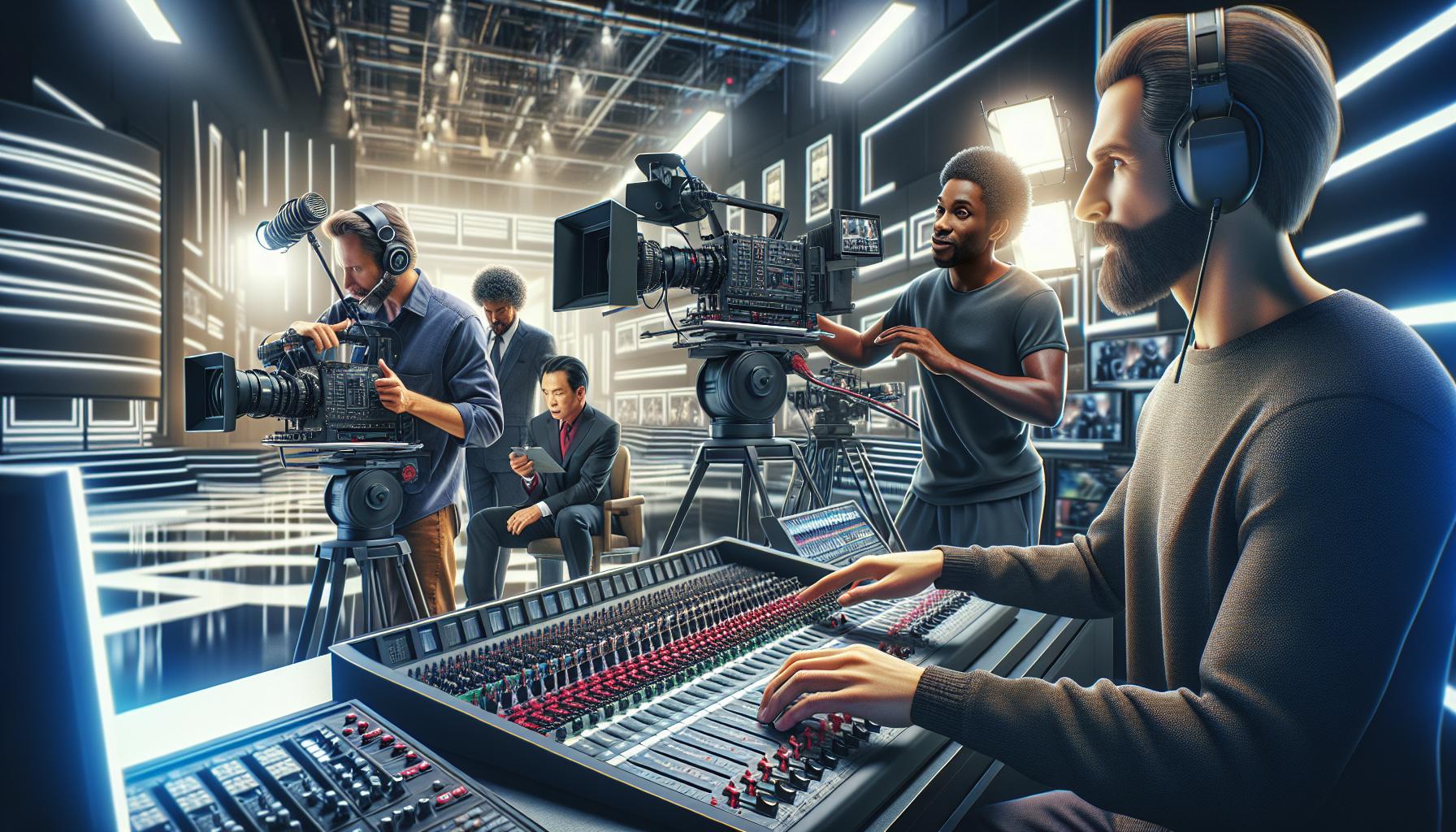Broadcast Media Production and Distribution
- Understanding Broadcast Media: Broadcast media production and distribution are essential components in shaping public perception and delivering diverse content across multiple platforms.
- Production Stages: The process includes vital stages: pre-production (planning and scripting), production (filming and recording), and post-production (editing and finalization), each critical for high-quality output.
- Distribution Channels: Effective distribution utilizes various channels, such as traditional broadcasting networks, streaming services, radio, and social media, to maximize audience reach and engagement.
- Challenges Faced: Media producers must navigate challenges like rapid technological advancements, regulatory compliance, and evolving audience expectations to maintain efficiency and relevance.
- Future Trends: The industry is shifting towards personalized content, technological integration (AI, VR, cloud computing), and a demand for diverse storytelling methods to meet modern viewer preferences.
In the ever-evolving landscape of communication, broadcast media production and distribution play a crucial role in shaping public perception and delivering content to diverse audiences. From television shows to radio programs and online streaming, the methods of creating and disseminating information have transformed dramatically, driven by technological advancements and changing consumer habits.
Understanding the intricacies of this industry is essential for anyone looking to navigate the complex world of media. Effective production techniques and strategic distribution channels can make the difference between a hit show and a forgotten project. As the demand for quality content continues to rise, grasping the fundamentals of broadcast media becomes not just beneficial but necessary for success in this competitive field.
Overview of Broadcast Media Production and Distribution
Broadcast media production involves creating audio and visual content for television, radio, and online platforms. This process encompasses various stages, including pre-production, production, and post-production.
Pre-production involves planning and scripting content. It includes organizing resources, casting talent, and scheduling shoots. Efficient pre-production ensures that projects run smoothly and stay within budget.
Production covers the actual filming or recording processes. It includes operating cameras, coordinating sound, and managing lighting. Skilled teams execute the vision set during pre-production, capturing high-quality content.
Post-production involves editing the footage, adding graphics and sound effects, and finalizing the product. This stage is crucial for refining content and enhancing its overall impact.
Distribution refers to delivering content to audiences through various channels. Traditional broadcast methods include satellite, cable, and over-the-air transmission. Digital platforms, such as streaming services and social media, have reshaped distribution, allowing for broader access and immediate viewership.
Key distribution channels include:
- Television Networks – Broadcast and cable channels reach millions of viewers simultaneously.
- Streaming Services – Platforms like Netflix and Hulu provide on-demand content.
- Radio Stations – Audio content delivered through AM, FM, and internet radio.
- Social Media – Platforms like YouTube and Facebook facilitate instant sharing and broad audience engagement.
Understanding these production methods and distribution channels is essential for succeeding in the ever-evolving media landscape. Effective strategies leverage both traditional and modern technologies for maximum reach and engagement.
Key Components of Broadcast Media Production

Broadcast media production encompasses several vital components that ensure successful content creation. Understanding these elements enhances the overall effectiveness of media projects.
Pre-Production Planning
Pre-production planning includes scriptwriting, budgeting, and scheduling. By detailing the project’s vision, teams define roles and responsibilities early on. This stage involves location scouting and securing permits, which mitigate risks during production. Developing a comprehensive timeline keeps projects on track, allowing for adjustments as needed. Effective pre-production identifies potential challenges, streamlining the process.
Production Techniques
Production techniques relate to the actual recording and filming of content. This phase engages diverse teams, including directors, cameramen, and sound engineers. Utilizing advanced technology improves video and audio quality. Lighting setups enhance visuals, while proper camera angles contribute to storytelling. Real-time direction during shooting ensures alignment with the creative vision, allowing for immediate adjustments. Professional equipment selection, such as cameras and sound mixers, plays a critical role in achieving high production values.
Post-Production Processes
Post-production processes focus on editing, sound design, and incorporating visual effects. Editing software enables precise cuts and transitions, shaping the final narrative. Sound engineers mix dialogue, music, and effects to create an immersive audio experience. Color grading enhances visual aesthetics, providing a polished look. This phase is crucial in ensuring the content meets industry standards and audience expectations. A well-executed post-production process maximizes impact and audience engagement.
Distribution Channels in Broadcast Media

Distribution channels play a crucial role in delivering broadcast media to audiences. Understanding these channels enhances content accessibility and audience engagement.
Traditional Broadcasting
Traditional broadcasting primarily involves television networks and radio stations. These channels deliver content through over-the-air signals, cable, or satellite. Major television networks, such as ABC, NBC, and CBS, reach millions of viewers using scheduled programming and advertising revenue. Radio stations operate similarly, providing news, music, and talk shows to diverse audiences. The Federal Communications Commission (FCC) regulates these broadcasts, ensuring compliance with standards. Traditional broadcasting maintains a significant presence despite the rise of digital alternatives, largely due to established audience habits and brand loyalty.
Digital Platforms and Streaming Services
Digital platforms and streaming services redefine content distribution in the modern era. Services like Netflix, Hulu, and Amazon Prime Video allow users to access content on-demand, adapting to viewer preferences. Platforms like YouTube and Facebook expand reach further by enabling user-generated content and live broadcasting. These services utilize subscription models, ad-supported options, or a combination, generating revenue while providing varied content. The accessibility of these platforms enhances audience engagement, enabling viewers to consume content anytime and anywhere. Integrating analytics and user feedback helps creators refine their strategies, ensuring content remains relevant and appealing.
Challenges in Broadcast Media Production and Distribution

Broadcast media production and distribution face several challenges that impact the efficiency and effectiveness of content delivery. Understanding these challenges is crucial for navigating the dynamic landscape of media.
Technological Advancements
Technological advancements constantly reshape broadcast media production and distribution. While they enhance capabilities, they also introduce complexities. Adapting to rapidly evolving technologies can strain budgets and require ongoing training. For instance, emerging technologies like high-definition video and 4K production demand investment in new equipment and software, increasing costs for production teams. Additionally, mastering new distribution platforms can overwhelm creators, as they must understand varying algorithms and user behaviors to maximize reach. Balancing innovation with practical implementation poses a significant challenge for media organizations.
Regulatory Issues
Regulatory issues also present hurdles in broadcast media. Compliance with broadcasting regulations requires extensive knowledge of local and international laws. Navigating copyright laws, content restrictions, and licencing agreements can be daunting. For example, obtaining copyright clearance for music or footage can delay production timelines and inflate costs. Furthermore, regulations governing advertising and content standards vary by region, complicating distribution strategies across multiple markets. Ensuring adherence to these regulations is essential to avoid legal repercussions and maintain a positive reputation in the industry.
Future Trends in Broadcast Media
Broadcast media continues to evolve rapidly due to shifts in audience expectations and technological advancements. Understanding these trends is vital for staying competitive in the industry.
Evolving Audience Expectations
Audience expectations are shifting toward personalized, high-quality content. Current viewers favor on-demand access, leading to the growth of tailored programming and niche content. They prefer interactive experiences over passive consumption, driving broadcasters to adopt viewer feedback and engagement strategies. Moreover, consumers increasingly seek diversity in content, prompting media producers to address various perspectives and stories. This trend toward customization allows for targeted marketing strategies that enhance viewer satisfaction.
Integration of New Technologies
Integration of new technologies significantly impacts broadcast media production. Advances in artificial intelligence (AI) and machine learning automate processes like editing and content analysis, improving efficiency. Virtual reality (VR) and augmented reality (AR) create immersive experiences, engaging audiences in innovative ways. Cloud computing streamlines collaboration among remote teams, enabling high-quality production from diverse locations. The rise of 5G technology enhances streaming capabilities, reducing latency and increasing accessibility. Adopting these technologies ensures content remains relevant and aligns with audience preferences.
Demands of Modern Audiences
Broadcast media production and distribution is a dynamic field that continues to evolve. As technology advances and audience preferences shift, media professionals must stay agile and informed. Mastering production techniques and understanding distribution channels are crucial for creating impactful content that resonates with viewers.
The landscape is marked by both challenges and opportunities. Navigating regulatory hurdles and investing in the latest technologies can be daunting. However, embracing these changes can lead to innovative storytelling and enhanced audience engagement.
Looking ahead, the integration of emerging technologies will further reshape how content is produced and distributed. By adapting to these trends, media organizations can thrive in a competitive environment and meet the demands of modern audiences.

